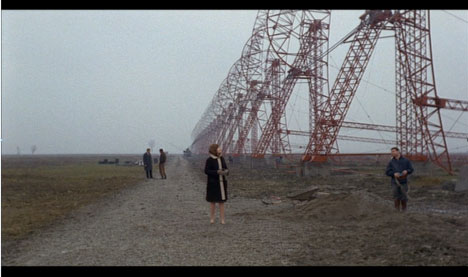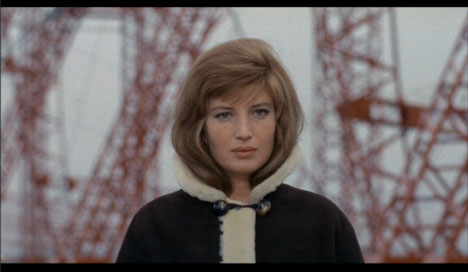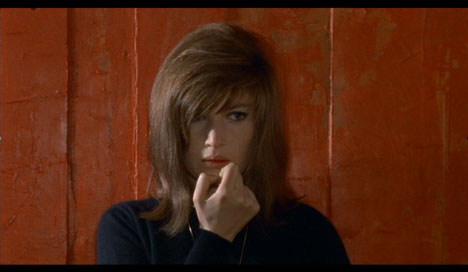Wandering through the Red Desert: Jewish Perspectives on a Film
By Asher Crispe: December 16, 2010: Category Inspirations, Quilt of Translations
Film, when done well, should ignite a spark of emotional intensity. In the hands of a master director, the castigating images may be felt to stare back at us in a nearly hypnotic fashion. The magic of the movies casts its spell upon us particularly when we are sucked into the story—a story that perhaps contains some parallels to our own personal story or the story of a people.
The films of Michelangelo Antonioni are renown for their characterization of the existential dimensions of the modern human condition. Among his many masterpieces celebrated in the annals of cinema, is his resplendent portrait of a young woman’s neurosis set against the backdrop of smoke and steel industrial landscapes known as Red Desert. First released in 1964, Red Desert has recently been released on Criterion DVD and continues to enjoy its status as one of the 20th century’s great works of film art. Having been transfixed by this film, which I count amongst my favorites, as well as Antonioni’s work as a whole, I cannot help but think it sets the stage (as strange as it may sound) for a continuing conversation about core Jewish themes—most specifically the language of exile and alienation.
 While the Torah and Jewish history present the account of the repeated exile or displacement of a people—be it the slavery in Egypt or the Diaspora after the destruction of the Second Temple—the inner dimensions of Jewish tradition extend this far beyond a mere historical reading. The language of exile is a model for understanding the most universal aspects of humanity. It is coming to describe an existential situation that speaks across time to all people. When boiled down to its essence, exile begins with a prior sense of being at home, of fitting in, of being well adjusted, of comfort zones and connectedness. All displacements are then precisely that: a feeling out of place, disconnected, alienated.
While the Torah and Jewish history present the account of the repeated exile or displacement of a people—be it the slavery in Egypt or the Diaspora after the destruction of the Second Temple—the inner dimensions of Jewish tradition extend this far beyond a mere historical reading. The language of exile is a model for understanding the most universal aspects of humanity. It is coming to describe an existential situation that speaks across time to all people. When boiled down to its essence, exile begins with a prior sense of being at home, of fitting in, of being well adjusted, of comfort zones and connectedness. All displacements are then precisely that: a feeling out of place, disconnected, alienated.
What happens when the whole world has changed and the old, familiar place where I once resided has vanished? Things are now not only new—they are foreign. Being that the last 100 years have brought unprecedented change to the world, for better or worse, how is one to adjust? What if my psyche can’t acclimate? All the maps are being redrawn and updated constantly—how is a person able to get settled or become attached if it is all going to change? This is through and through in every aspect of life. Social dynamics, economics, technology, fashion—not to mention the land itself is being remade constantly. Who can keep up?
This is the dilemma of Giuliana, the central character of Red Desert, who cannot feel the floor under her. She has a nightmare of falling into quicksand because all of the anchors of personal identity are being whisked away. Even the environment has transmuted, being brought up and built upon. Antonioni plays with all of the tools of the film maker, be it editing or color palates, to impress upon the viewer the blurring of boundaries, the disorientation in space and time, body and soul.
Juhani Pallasmaa, in remarking about this and other films of the director, notes that “…the inner mental space of the characters and the outer space of the setting create a continuum….” This same statement could be applied to all Chassidic readings of the Torah. There is outer exile and inner exile. The topography of the Biblical world is integrated seamlessly into the psycho-spiritual realms of Jewish consciousness. This awareness offers the descriptive language of exile and returning home or being redeemed to the world at large. Judaism teaches of a future of Messianic promise as the return from exile but the exile is a necessary condition of the return. Some integral experience is gained by being displaced to begin with. It is all part of the process. Seek before you find and have the experience to know what you have found.
Of all of the fantastic images of the film, the one that provided the most uncanny sense of alienation is when Giuliana is standing in front of a giant Radio telescope array that is being erected by the University of Bologna. Listening to the hidden murmuring of the universe, hoping to detect signs of life elsewhere, that there might be something being communicated across the void or within the void itself if we just listen to it, frames an entire generation as well as this one woman’s pain of alienation. On the positive side, look how far we are willing to go—even constructing massive mechanical ears—just to make contact with our reason to be or sense of purpose or the meaning of it all in the universe. Half the problem of exile is solved in the realization that we are in exile to begin with. Technology, with all of its shock and awe, is ultimately aiding this search. It is assisting the transition. Sometimes it is the transition and sometimes it is making the transition faster as we speed to a new life over the horizon.
 One of Antonioni’s self-reflective utterances summarizes the entire tumultuous process of transition from who we have been to who we will be: “A new man is being born, fraught with all the fears and terrors and stammerings that are associated with a period of gestation.” There is a certain striking resonance with the Midrashic teachings of the Sages, when they equated exile (modeling all future exiles and redemptions on the original exodus narrative) with being in a state of pregnancy, while the release from confinement and limitation was depicted as the resultant birth process. There is bound to be some trauma in this as the archetype of all transitions.
One of Antonioni’s self-reflective utterances summarizes the entire tumultuous process of transition from who we have been to who we will be: “A new man is being born, fraught with all the fears and terrors and stammerings that are associated with a period of gestation.” There is a certain striking resonance with the Midrashic teachings of the Sages, when they equated exile (modeling all future exiles and redemptions on the original exodus narrative) with being in a state of pregnancy, while the release from confinement and limitation was depicted as the resultant birth process. There is bound to be some trauma in this as the archetype of all transitions.
What the Torah teaches in all of this is that the very awareness of the process, accompanied with the willingness to adapt to the new, softens the impact of the transition that continues to carry all of humanity forward and which, we may aspire to greet with joy.
*Note all screen shots are copyright of The Criterion Collection
Wandering through the Red Desert: Jewish Perspectives on a Film,













;)
;)
;)
;)
;)
;)
;)
;)
;)
;)
